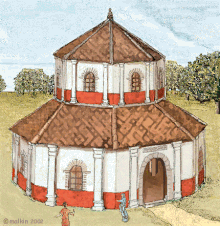ThePagans Hill Roman Templewas aRomano-British-styletemple(Romano-Celtic temple) excavated on Pagans Hill atChew Stokein theEnglishcounty ofSomerset.
 A reconstruction drawing of Pagans Hill Roman Temple | |
Map showing the location of Pagans Hill Roman Temple inSomerset. | |
| Location | Chew Stoke,Somerset. |
|---|---|
| Region | South-West |
| Coordinates | 51°21′39″N2°38′14″W/ 51.360732°N 2.6373580°W |
| Type | Romano-Celtic Temple |
| History | |
| Founded | 3rd Century AD |
| Abandoned | 4th Century AD |
| Cultures | Roman |
| Management | English Heritage |
History
editThe temple faced east and was first built in the late-3rd century, possibly to the godMercury.[1]After the collapse of the original building another temple was built, which again fell into ruin. The final rebuild, after about 367 CE included the addition of an internal screen. The latest dateable coin found at the site was ofArcadius(383–408). The last building collapsed in the 5th century.[2]
The site of the temple is on the aptly named Pagans Hill, although that name is modern[3]and any link to the site in the naming of the road has been lost.[4]
Appearance
editIt was a double-octagonaltemple building comprised an inner wall, which formed thecellaor sanctuary, surrounded by an outer wall forming anambulatory,or covered walkway. The outerporticomeasures about 56½ feet in diameter, the inner cellar about 32 feet across. All walls were about 3 feet thick. Along each wall were two features described by Rahtz asbuttressesbut were more likely to have beenpilasters,as their small size would render them ineffective as wall supports.Warwick Rodwellsuggests that the ambulatory would have been cross-vaulted and the pilasters used as external supports for this. This would allow for a good deal of natural light to circulate the building and give an aesthetically balanced look to the structure. The ambulatory would then give the illusion of alabyrinthof side chambers running off from the central area.[5]
The site formed a large pilgrimage centre including guest houses and priest's house as well as the octagonal temple andholy well.[6]
Excavations
editThe temple was on a promontory overlooking theRiver Chew.It was excavated byPhilip Rahtzbetween 1949 and 1953.[7][8]In addition to the foundations of the temple awell(17 metres deep) and severalditcheswere found which contained smallartifactsshowing occupation of the site before theRomanperiod includingpotteryofIron Agetype,[9]and acoindating from c. 335–337 CE.[10]Evidence of continuing use after the Roman period is provided by a bucket and an exotic 7th centuryglassjar found in the well.[11]
It was originally thought, on its discovery in 1830, to have been abeacon,for signalling between adjoininghill forts.
Pagans Hill Dog
editAmong the artefacts found in the well approximately 15 meters west of the temple foundations, was an unusual sculpture of a dog with collar. The statue was in four sections, measured 63 cm in height overall and was made of Doulting Stone, a limestone, as still quarried today atDoulting Stone Quarry.[10]
See also
editReferences
edit- ^Aston, Michael;Iles, Rob (1987).The archaeology of Avon.Bristol: Avon County Council.ISBN0-86063-282-2.
- ^"Pagans Hill temple".Curse tablets from Roman Britain.Retrieved14 November2010.
- ^MacInnes, Charles Malcolm; Whittard, Walter Frederick (1973).Bristol and its adjoining counties.p. 174.
- ^Dunning, Robert (1983).A History of Somerset.Chichester: Phillimore & Co.ISBN0-85033-461-6.
- ^Rodwell, Warwick (1980).Temples, Churches and Religion: Recent Research in Roman Britain.Chichester: British Archaeological Reports.ISBN0-86054-085-5.
- ^Ford, David Nash."Narrative History of the County of Somerset".Britannia.Archived fromthe originalon 12 November 2006.Retrieved3 January2007.
- ^Rahtz, P.; Harris, L.G. (1958). "The temple well and other buildings at Pagans Hill, Chew Stoke, North Somersetshire".Proceedings of the Somersetshire Archaeological and Natural History Society:25–51.
- ^Rahtz, P.; Watts, L. (1991). "Pagans Hill revisited".The Archaeological Journal.46.
- ^Hucker, Ernest (1997).Chew Stoke recalled in old photographs.Ernest Hucker.
- ^abBoon, George C. (1989). "A Roman sculpture rehabilitated: The Pagans Hill dog".Britannia.20.Society for the Promotion of Roman Studies: 201–217.doi:10.2307/526163.JSTOR526163.
- ^Gelling, Margaret."Temples in Somerset and neighbouring areas"(PDF).Archeology Data Service.Retrieved3 January2007.
